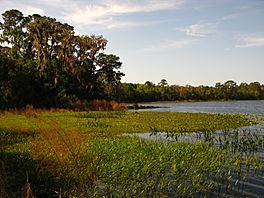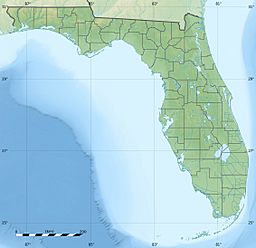Lake Suggs facts for kids
Quick facts for kids Lake Suggs |
|
|---|---|
| Suggs Lake | |

Lake Suggs, 2008
|
|
| Coordinates | 29°41′13″N 82°00′58″W / 29.68705°N 82.01617°W |
| Type | Lake |
| Basin countries | United States |
| Surface area | 0.73 km2 (0.28 sq mi) |
| Max. depth | 5.7 m (19 ft) |
| Surface elevation | 29 m (95 ft) |
Lake Suggs, also known as Suggs Lake, is a lake located in Putnam County, Florida. It is part of the Ordway-Swisher Biological Station, which is managed by the Institute of Food and Agricultural Sciences.
Lake Suggs is a special type of wetland called a seepage lake. This means it gets most of its water from rain and from underground water, not from rivers flowing into it. It is also considered a baygall, which is a kind of swampy area with specific types of trees and plants.
Scientists have been studying the water in Lake Suggs since the 1970s. They use special wells to check how water moves underground. This helps them understand the hydrology (how water moves) of the area, including how Lake Suggs connects to nearby Lake Barco.
About Lake Suggs
Lake Suggs is a small lake, covering about 0.73 square kilometers (0.28 square miles). It is known as a mesotrophic lake, which means it has a medium amount of nutrients.
The lake does not have much water flowing in or out on the surface. However, a lot of water moves between the lake and the underground water system. Lake Suggs is also quite shallow, with an average depth of about 2.5 meters (8.2 feet). Its deepest point is 5.7 meters (18.7 feet).
Water Chemistry
The water in Lake Suggs has a lot of dissolved organic carbon. This comes from decaying plants and other natural materials. Because of this, the lake water is quite acidic. Its pH level is around 4.74, which is similar to the acidity of black coffee.
Animals and Plants
The area around Lake Suggs is surrounded by beautiful cypress swamps and thick hardwood forests. These habitats are home to many different animals.
Amphibians in the Lake
Lake Suggs is especially rich in amphibians. These are animals like frogs and salamanders that can live both in water and on land. Many types of salamanders live here, including those from the Siren, Amphiuma, and Pseudobranchus groups.


